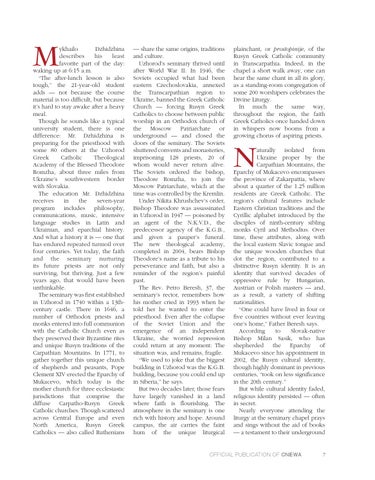M
ykhailo Dzhidzhina describes his least favorite part of the day: waking up at 6:15 a.m. “The after-lunch lesson is also tough,” the 21-year-old student adds — not because the course material is too difficult, but because it’s hard to stay awake after a heavy meal. Though he sounds like a typical university student, there is one difference: Mr. Dzhidzhina is preparing for the priesthood with some 80 others at the Uzhorod Greek Catholic Theological Academy of the Blessed Theodore Romzha, about three miles from Ukraine’s southwestern border with Slovakia. The education Mr. Dzhidzhina receives in the seven-year program includes philosophy, communications, music, intensive language studies in Latin and Ukrainian, and eparchial history. And what a history it is — one that has endured repeated turmoil over four centuries. Yet today, the faith and the seminary nurturing its future priests are not only surviving, but thriving. Just a few years ago, that would have been unthinkable. The seminary was first established in Uzhorod in 1740 within a 13thcentury castle. There in 1646, a number of Orthodox priests and monks entered into full communion with the Catholic Church even as they preserved their Byzantine rites and unique Rusyn traditions of the Carpathian Mountains. In 1771, to gather together this unique church of shepherds and peasants, Pope Clement XIV erected the Eparchy of Mukacevo, which today is the mother church for three ecclesiastic jurisdictions that comprise the diffuse Carpatho-Rusyn Greek Catholic churches. Though scattered across Central Europe and even North America, Rusyn Greek Catholics — also called Ruthenians
— share the same origins, traditions and culture. Uzhorod’s seminary thrived until after World War II. In 1946, the Soviets occupied what had been eastern Czechoslovakia, annexed the Transcarpathian region to Ukraine, banned the Greek Catholic Church — forcing Rusyn Greek Catholics to choose between public worship in an Orthodox church of the Moscow Patriarchate or underground — and closed the doors of the seminary. The Soviets shuttered convents and monasteries, imprisoning 128 priests, 20 of whom would never return alive. The Soviets ordered the bishop, Theodore Romzha, to join the Moscow Patriarchate, which at the time was controlled by the Kremlin. Under Nikita Khrushchev’s order, Bishop Theodore was assassinated in Uzhorod in 1947 — poisoned by an agent of the N.K.V.D., the predecessor agency of the K.G.B., and given a pauper’s funeral. The new theological academy, completed in 2004, bears Bishop Theodore’s name as a tribute to his perseverance and faith, but also a reminder of the region’s painful past. The Rev. Petro Beresh, 37, the seminary’s rector, remembers how his mother cried in 1993 when he told her he wanted to enter the priesthood. Even after the collapse of the Soviet Union and the emergence of an independent Ukraine, she worried repression could return at any moment: The situation was, and remains, fragile. “We used to joke that the biggest building in Uzhorod was the K.G.B. building, because you could end up in Siberia,” he says. But two decades later, those fears have largely vanished in a land where faith is flourishing. The atmosphere in the seminary is one rich with history and hope. Around campus, the air carries the faint hum of the unique liturgical
plainchant, or prostopinije, of the Rusyn Greek Catholic community in Transcarpathia. Indeed, in the chapel a short walk away, one can hear the same chant in all its glory, as a standing-room congregation of some 200 worshipers celebrates the Divine Liturgy. In much the same way, throughout the region, the faith Greek Catholics once handed down in whispers now booms from a growing chorus of aspiring priests.
N
aturally isolated from Ukraine proper by the Carpathian Mountains, the Eparchy of Mukacevo encompasses the province of Zakarpattia, where about a quarter of the 1.25 million residents are Greek Catholic. The region’s cultural features include Eastern Christian traditions and the Cyrillic alphabet introduced by the disciples of ninth-century sibling monks Cyril and Methodius. Over time, these attributes, along with the local eastern Slavic tongue and the unique wooden churches that dot the region, contributed to a distinctive Rusyn identity. It is an identity that survived decades of oppressive rule by Hungarian, Austrian or Polish masters — and, as a result, a variety of shifting nationalities. “One could have lived in four or five countries without ever leaving one’s home,” Father Beresh says. According to Slovak-native Bishop Milan Sasik, who has shepherded the Eparchy of Mukacevo since his appointment in 2002, the Rusyn cultural identity, though highly dominant in previous centuries, “took on less significance in the 20th century.” But while cultural identity faded, religious identity persisted — often in secret. Nearly everyone attending the liturgy at the seminary chapel prays and sings without the aid of books — a testament to their underground
OFFICIAL PUBLICATION OF CNEWA
7
